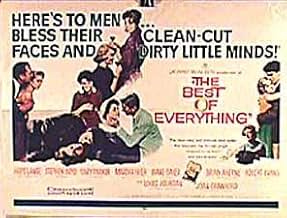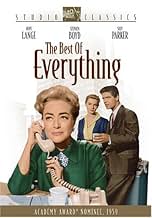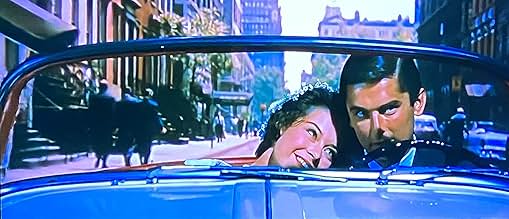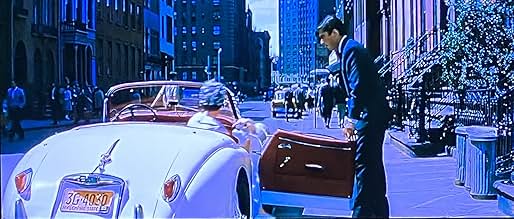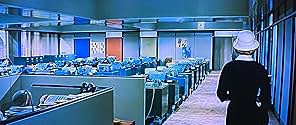CALIFICACIÓN DE IMDb
6.6/10
2.5 k
TU CALIFICACIÓN
Una exposición de las vidas y los amores de las chicas trabajadoras de Madison Avenue y sus altos mandos.Una exposición de las vidas y los amores de las chicas trabajadoras de Madison Avenue y sus altos mandos.Una exposición de las vidas y los amores de las chicas trabajadoras de Madison Avenue y sus altos mandos.
- Dirección
- Guionistas
- Elenco
- Nominado a 2 premios Óscar
- 2 nominaciones en total
Linda Hutchins
- Jane
- (as Linda Hutchings)
Ted Otis Sr.
- Dr. Ronnie Wood
- (as Ted Otis)
Gertrude Astor
- Leading Woman in Play
- (sin créditos)
Alan Austin
- Bill
- (sin créditos)
Joseph Bardo
- Policeman
- (sin créditos)
Opiniones destacadas
Claire Booth Luce's "The Women" shows relationships with men through a woman's point of view in a play, (and 1939 film that also has Joan Crawford playing a bitch: a character who might have been Amanda Farrow 20 years before), that has no male characters. Here we see the male characters and what a bunch they are. They use women like toys and throw them away, leaving the women to suffer. Ironically, the women in "The Women", perhaps because they are all we see, are shown in a less than favorable light, alternately silly and scheming, with the only "nice" one, (Norma Shearer), growing "claws" by the end. In "The Best of Everything" we see the men for the cads they are while the women are largely innocent and vulnerable.
This is a film about women leaping from things. Diane Baker leaps from a car, (in perhaps the most absurd scene in cinema history, which is not in the book). Suzy Parker falls from a fire escape. The women in the film are leaping into the workplace, looking for success and love at the same time. Women would leap into the future and leave this type of soap opera behind in the next decade. But they would come back to it in the 80's and 90's through the novels of people like Sidney Sheldon and Judith Krantz, (although their trashier works aren't as good as this).
The best thing about this film is the way it looks. I love the glossy cinemascope films of the 50's and 60's. They look so much better than the pixel-challenged home movies we've been making since, especially in the letterboxed version we see on TV, and the DVD, with the picture so clear you could walk into it. The look of the bevy of young beauties in it is also memorable. This film probably has more beautiful women in it than any other. It has a supermodel, (Suzy Parker), a beauty queen, (Myrna Hansen, who was not Miss America 1954 as Rona Jaffe says in the DVD commentary but rather Miss USA 1953, per the IMDb: but so what), and a Playboy playmate, (June Blair, from January 1957). My vote goes to Suzy, one of the astonishing beauties of all time. Her acting here isn't as awful as people pretend: they are just reacting, as people did then, to the sight of a supermodel, (the first, really), trying to act. Nobody seemed to care how well she did. Her role, that of an apparently worldly woman who turns out to be the most vulnerable, is the most complex in the bunch and she does just fine.
The most touching thing about the film now is the age of the female leads at the time. Hope Lange was 27 when they filmed this in the spring of 1959. Diane Baker was 20. Suzy Parker was 26. Hope, who looked to be Grace Kelly's heir, never made it really big and wound up being Mrs. Muir on television and, per the IMDb, wound up living in a home with "crates for coffee tables" because she spent her money on causes she believed in before dying at age 72 in 2003. This film must have seemed a very distant and irrelevant memory to her by then. Baker, always a welcome face in 60's TV, (especially to Richard Kimble), and still active as an actress and acting coach, just turned 67. Parker found "the best of everything" with Bradford Dillman for 40 years before dying at age 70 the same year Lange did. But here they are, young, beautiful and ambitious for success and love, just like their characters.
This is a film about women leaping from things. Diane Baker leaps from a car, (in perhaps the most absurd scene in cinema history, which is not in the book). Suzy Parker falls from a fire escape. The women in the film are leaping into the workplace, looking for success and love at the same time. Women would leap into the future and leave this type of soap opera behind in the next decade. But they would come back to it in the 80's and 90's through the novels of people like Sidney Sheldon and Judith Krantz, (although their trashier works aren't as good as this).
The best thing about this film is the way it looks. I love the glossy cinemascope films of the 50's and 60's. They look so much better than the pixel-challenged home movies we've been making since, especially in the letterboxed version we see on TV, and the DVD, with the picture so clear you could walk into it. The look of the bevy of young beauties in it is also memorable. This film probably has more beautiful women in it than any other. It has a supermodel, (Suzy Parker), a beauty queen, (Myrna Hansen, who was not Miss America 1954 as Rona Jaffe says in the DVD commentary but rather Miss USA 1953, per the IMDb: but so what), and a Playboy playmate, (June Blair, from January 1957). My vote goes to Suzy, one of the astonishing beauties of all time. Her acting here isn't as awful as people pretend: they are just reacting, as people did then, to the sight of a supermodel, (the first, really), trying to act. Nobody seemed to care how well she did. Her role, that of an apparently worldly woman who turns out to be the most vulnerable, is the most complex in the bunch and she does just fine.
The most touching thing about the film now is the age of the female leads at the time. Hope Lange was 27 when they filmed this in the spring of 1959. Diane Baker was 20. Suzy Parker was 26. Hope, who looked to be Grace Kelly's heir, never made it really big and wound up being Mrs. Muir on television and, per the IMDb, wound up living in a home with "crates for coffee tables" because she spent her money on causes she believed in before dying at age 72 in 2003. This film must have seemed a very distant and irrelevant memory to her by then. Baker, always a welcome face in 60's TV, (especially to Richard Kimble), and still active as an actress and acting coach, just turned 67. Parker found "the best of everything" with Bradford Dillman for 40 years before dying at age 70 the same year Lange did. But here they are, young, beautiful and ambitious for success and love, just like their characters.
I am still trying to figure out why I like this film (and so many like it), when in truth, the submissiveness of females and their dependence on the love of a man really sickens me. The depiction of women in this film is perhaps a bit more progressive than that in other films of this genre, as the women are, at least, career women, and much of the story is set in the office. However, among the three key friends (Hope Lange, Suzy Parker, and Diane Baker), Lange's character Caroline Bender is the only one determined to be an editor. However, at the same time, when her colleague Mike Rice (Stephen Boyd) asks her if she has any ambitions beyond working a year or so, she quite adamantly says "no..none at all"...so, it's a bit contradictory, and frustrating. And he, of course, says it's "wonderful" when she agrees with him that it would be quite satisfying for her to "get her feet wet in publishing for a year or two to prove what she has "to prove", marry a doctor or lawyer, and have babies".
Some of the dialog is beyond hope, but I inexplicably continue to watch this film, every so often. Maybe it's the women's clothing...I love suits, and I miss dressing up for work. (Business casual has been one of several downfalls of today's workplace, as far as I'm concerned. Even though I'm a die-hard liberal, I definitely appreciate and enjoy conservative dress). No, but really...perhaps it is because I want to see if at least one of these women wakes up and takes stock in her own life, and throws back all of the crap that her "sweetheart" dishes out at her. Hope Lange does so to a degree when she rhetorically asks her slime-bucket hometown beau Eddie "what is it about men that they think they deserve the most refined, cultured, "respectable" women from the "best schools and the best families" only "part-time", for only fun, but ignore all of the attendant responsibilities that would turn frolic into long-term, serious relationships. She then goes on to say that a number of women will play the same game as men, for a while, but eventually, they'll have to pick up a few extra men of their own, to fill in the time when they're not with the one they really want. I guess she's talking about today's "casual dating" and "hooking up". Having spent some time lately with various dating services, I've run into more slime-buckets during the past year than I have in my entire life. Again, even though politically I'm quite liberal, my own social mores lean far more to those of a "Rules Girl". So, this piece of dialog resonated with me at this time in my life.
The opening credits are very nice...Manhattan in the spring/summertime is always glorious. Though I need to laugh that it's Johnny Mathis singing the title song, "The Best of Everything" (I've always thought that he was a very funny singer...he often breaks what should be long-held notes with silence...perhaps he's breathing, but we don't hear him inhale), it's also perfect....who else would be singing this song for a 1950's movie about finding your way in life and in love.
Joan Crawford's boss is in many ways no different from some of the tyrannical maniacs I've worked for today, no joke. Joan Crawford's Amanda Farrow was more or less a direct, no holds barred, right-in-your face bitch, telling Hope Lange that she does not have what it takes to become a Reader, much less an Editor. And, she did it in front of the rest of the typing pool (how unprofessional is that?). In the 80's, people stabbed you in the back. In the 90's, and to a degree, now, people smile at you directly, and let you believe all is well, until you're laid off in one surprising second.
I found it inconsistent how the Suzy Parker character started out as an independent, career-minded, aspiring actress, who prided herself on never having needed a man ("to love, and to let go...that's me"), but ended up becoming the most debilitated by the rejection of a man with whom she had fallen in love. And of course, it's also amazing how Diane Baker, fresh from being thrown out of a speeding car and losing a baby (out of wedlock, no less, in the 1950's!) manages to attract the attention and heart of a young, studly doctor when she's still wearing bandages and no make-up in her hospital bed. Wonders never cease in a 1950's melodrama!
If you hedonistically enjoy "Valley of the Dolls", or "Written on the Wind", you'll love "The Best of Everything".
Some of the dialog is beyond hope, but I inexplicably continue to watch this film, every so often. Maybe it's the women's clothing...I love suits, and I miss dressing up for work. (Business casual has been one of several downfalls of today's workplace, as far as I'm concerned. Even though I'm a die-hard liberal, I definitely appreciate and enjoy conservative dress). No, but really...perhaps it is because I want to see if at least one of these women wakes up and takes stock in her own life, and throws back all of the crap that her "sweetheart" dishes out at her. Hope Lange does so to a degree when she rhetorically asks her slime-bucket hometown beau Eddie "what is it about men that they think they deserve the most refined, cultured, "respectable" women from the "best schools and the best families" only "part-time", for only fun, but ignore all of the attendant responsibilities that would turn frolic into long-term, serious relationships. She then goes on to say that a number of women will play the same game as men, for a while, but eventually, they'll have to pick up a few extra men of their own, to fill in the time when they're not with the one they really want. I guess she's talking about today's "casual dating" and "hooking up". Having spent some time lately with various dating services, I've run into more slime-buckets during the past year than I have in my entire life. Again, even though politically I'm quite liberal, my own social mores lean far more to those of a "Rules Girl". So, this piece of dialog resonated with me at this time in my life.
The opening credits are very nice...Manhattan in the spring/summertime is always glorious. Though I need to laugh that it's Johnny Mathis singing the title song, "The Best of Everything" (I've always thought that he was a very funny singer...he often breaks what should be long-held notes with silence...perhaps he's breathing, but we don't hear him inhale), it's also perfect....who else would be singing this song for a 1950's movie about finding your way in life and in love.
Joan Crawford's boss is in many ways no different from some of the tyrannical maniacs I've worked for today, no joke. Joan Crawford's Amanda Farrow was more or less a direct, no holds barred, right-in-your face bitch, telling Hope Lange that she does not have what it takes to become a Reader, much less an Editor. And, she did it in front of the rest of the typing pool (how unprofessional is that?). In the 80's, people stabbed you in the back. In the 90's, and to a degree, now, people smile at you directly, and let you believe all is well, until you're laid off in one surprising second.
I found it inconsistent how the Suzy Parker character started out as an independent, career-minded, aspiring actress, who prided herself on never having needed a man ("to love, and to let go...that's me"), but ended up becoming the most debilitated by the rejection of a man with whom she had fallen in love. And of course, it's also amazing how Diane Baker, fresh from being thrown out of a speeding car and losing a baby (out of wedlock, no less, in the 1950's!) manages to attract the attention and heart of a young, studly doctor when she's still wearing bandages and no make-up in her hospital bed. Wonders never cease in a 1950's melodrama!
If you hedonistically enjoy "Valley of the Dolls", or "Written on the Wind", you'll love "The Best of Everything".
I feel very strongly that this film was just like Waiting to Exhale with white females in the 1950's. As in Waiting to Exhale, all of the female characters got mixed up with men who were either married or no good. The only difference, besides the obvious, was that there wasn't much humor in this film. I would even say that it was tragic. Only one of the male characters seemed to be kind and sincere (Hope Lange's guy), but even then there was conflict in this relationship.
The story was about three young women who shared an apartment together and who had hopes and dreams of success. Unfortunately for them, romance didn't seem to come easy although they were young, intelligent and attractive. This movie could be called a tearjerker with the saddest part involving Suzy Parker's character whose obsession of an ex-boyfriend leads to tragedy.
This is a must see.
The story was about three young women who shared an apartment together and who had hopes and dreams of success. Unfortunately for them, romance didn't seem to come easy although they were young, intelligent and attractive. This movie could be called a tearjerker with the saddest part involving Suzy Parker's character whose obsession of an ex-boyfriend leads to tragedy.
This is a must see.
Meant to be a glossy romance and cautionary tale for girls who dare to think of working Outside The Home, "The Best of Everything" instead is a virtual primer of the root causes of the modern Women's movement: Women (really, girls) can have jobs, but only until they find a man and leave to begin their real lives as homemakers; women are sexual toys, provided to men at work for their amusement; all men are predators and all women are fools; pregnancy is entirely the woman's fault; women who take their jobs seriously are damaged people; women merely exist for the use of men. Sounds like an unremitting screed, and it is -- yet, such is Hollywood's power, the pageant is very watchable (the clothes, the sentimental views of 1959 NYC) and beautiful. A wonderful snapshot of America just a couple of years before "The Feminine Mystique" was published. Must-see for women.
The Best of Everything is a high gloss large screen soap opera which follows the careers of four career women, Hope Lange, Suzy Parker, Diane Baker, and Martha Hyer at a New York publishing firm. What's the best for some women is not necessarily the best for all.
Presiding over this group of young fillies is wise old mare Joan Crawford who's been around the track a few times on screen and in real life. She looks right at home as the boss lady as well she should have at this point.
Around the time she was making The Best of Everything Joan Crawford became a widow when her fourth husband, Alfred Steele died. It was a particularly traumatic event for her, she woke up one morning and found him dead in bed next to her. She inherited all of his stock in Pepsi Cola where he was the board chairman and during the same period as The Best of Everything was being made, she wound up the queen bee at Pepsi Cola. Life does sometimes imitate art. So that authority as she barks out dictation and coffee orders to Hope Lange rings real true.
In fact all the women here with the exception of Lange are in for some rough sledding. It's rough for Lange too, but she literally makes the best of everything.
What a collection of stinkers the men are in this film. The best of them, Stephen Boyd, is a heavy drinker. The others Louis Jourdan, Robert Evans, and Brett Halsey, are as slimy a collection of rodents as ever gathered for one film.
I can't forget Brian Aherne either who's the fanny pinching head of this publishing firm. Half that office would have sexual harassment suits going today.
Some nice location shots of New York in the fifties make the film a real treat. Catch it by all means.
Presiding over this group of young fillies is wise old mare Joan Crawford who's been around the track a few times on screen and in real life. She looks right at home as the boss lady as well she should have at this point.
Around the time she was making The Best of Everything Joan Crawford became a widow when her fourth husband, Alfred Steele died. It was a particularly traumatic event for her, she woke up one morning and found him dead in bed next to her. She inherited all of his stock in Pepsi Cola where he was the board chairman and during the same period as The Best of Everything was being made, she wound up the queen bee at Pepsi Cola. Life does sometimes imitate art. So that authority as she barks out dictation and coffee orders to Hope Lange rings real true.
In fact all the women here with the exception of Lange are in for some rough sledding. It's rough for Lange too, but she literally makes the best of everything.
What a collection of stinkers the men are in this film. The best of them, Stephen Boyd, is a heavy drinker. The others Louis Jourdan, Robert Evans, and Brett Halsey, are as slimy a collection of rodents as ever gathered for one film.
I can't forget Brian Aherne either who's the fanny pinching head of this publishing firm. Half that office would have sexual harassment suits going today.
Some nice location shots of New York in the fifties make the film a real treat. Catch it by all means.
¿Sabías que…?
- TriviaJoan Crawford, recently elected to the board of directors of Pepsi after the death of her husband who had been President and CEO of the company, managed to swing a brief quasi product plug for the soft drink by having an unmistakable Pepsi machine (with the red, white, and blue Pepsi logo, but sans the word "Pepsi") installed in the secretaries' on-screen break room.
- ErroresIn the scene when Diane Baker tells Hope Lange "he's ten foot tall to me" while walking down the street, several people... two men and two young boys... look into the camera, smiling (they were obviously filming with a camera hidden in a car during these scenes as those people weren't extras).
- Citas
Amanda Farrow: Now you and your rabbit-faced wife can both go to hell!
- ConexionesFeatured in Playboy's Penthouse: Episode #1.1 (1959)
- Bandas sonorasThe Best of Everything
by Sammy Cahn and Alfred Newman
Johnny Mathis sings during the opening credits
Also sung by a chorus at the end
Played often in the score
Selecciones populares
Inicia sesión para calificar y agrega a la lista de videos para obtener recomendaciones personalizadas
- How long is The Best of Everything?Con tecnología de Alexa
Detalles
- Fecha de lanzamiento
- País de origen
- Idioma
- También se conoce como
- The Best of Everything
- Locaciones de filmación
- Productoras
- Ver más créditos de la compañía en IMDbPro
Taquilla
- Presupuesto
- USD 2,500,000 (estimado)
- Tiempo de ejecución2 horas 1 minuto
- Color
- Relación de aspecto
- 2.35 : 1
Contribuir a esta página
Sugiere una edición o agrega el contenido que falta


